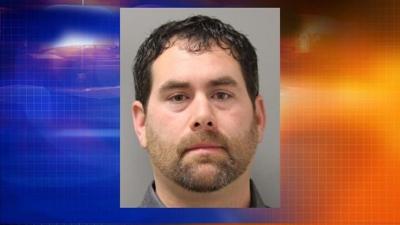GEORGETOWN, Del.- Following two days of testimony, a Sussex County Superior Court jury convicted the driver charged in last year's bicycle crash that led to the death of longtime WBOC owner Thomas Draper.
Shawn Armstrong was found guilty of operation of a vehicle causing the death of another person and inattentive driving in connection with the Sept. 7, 2017 incident that occurred in Slaughter Beach outside of Milford.
Armstrong could face up to 30 months behind bars when sentenced on Oct. 26, according to the Delaware Department of Justice. Armstrong did not speak to WBOC after the verdict, but his attorney, Michael Abram, expressed disbelief as he left the courthouse.
"I don't know what evidence the jury saw," he said. "I'm confused."
Abram told WBOC he assumed they would appeal the verdict. Members of Draper's family, meanwhile, say the verdict brought some sense of relief.
"The reality is the damage is done for us. There is no bringing my father back," said Draper's son, Hank Draper. "I don't personally have any ill will or vengeful feelings about Shawn Armstrong, but he is going to have to live with this for the rest of his life."
"I am just glad it was proved my dad didn't erratically pull out in front of him as if he does not know how to ride a bicycle," Draper concluded. Draper told WBOC he plans to speak at the sentencing in October.
The Trial
Armstrong's trial got underway Monday in Sussex County Superior Court with jury selection, opening statements and four witnesses called to the stand.
The trial resumed Tuesday morning with the defense stating its case.
The defense called to the stand Brian Jackson, one of Armstrong's employees. Jackson, who works with Armstrong for EH Custom Homes, was building a home addition in Slaughter Beach the day of the accident. Jackson testified that on his way to the project site, he passed a man riding a bicycle and wearing a green vest. He said that at around 7:30 a.m. he saw the man biking on the shoulder by the fire house. Jackson said he infers the man was Mr. Draper because he saw the same biker a number of times during the six to seven months he worked on the project in Slaughter Beach, but never saw the man after the accident. Jackson testified the biker was always in the shoulder when he saw him. He also said on the day of the accident, the sun was bright but there were no other distractions. During cross examination, the prosecution poked holes at Jackson's motive and memory, pointing out that Jackson never spoke to police, and he could not recall the exact weather, bike or helmet color that day. The prosecution also said Jackson's description of the biker's location was roughly three-quarter of a mile before the crash site, and 20-30 minutes ahead of Armstrong's timeline, so the timing would not make sense. The prosecution also pressed Jackson that he can't be sure the man he saw was Mr. Draper. Defendant Testimony After a brief re-direct by the defense, Armstrong took the stand. He described his job as a supervisor for EH Custom Homes and the work site in Slaughter Beach. Again, Armstrong said he saw Mr. Draper biking on the shoulder. Armstrong testified that when he first noticed Mr. Draper, he was a couple hundred yards behind him. He also testified he was not distracted-- he said he was not eating breakfast or playing with the radio before the crash. During Monday's courtroom action, speed, impairment, and cellphone use were essentially ruled out as contributing factors in the crash, as per a Delaware State Police investigation. Armstrong testified that Mr. Draper veered off a foot or two into the roadway before the accident. "There was nothing I could've done. It just happened so quick," Armstrong told the court. Armstrong also described how he tried to call 911 and due to a phone error, he could not hear 911 at first and began to panic. He said he was then next to Mr. Draper with his hand on his back "to let him know I was there." Armstrong described trying to keep Mr. Draper still and then holding his head when the state trooper arrived. Next, the defense played the 911 call from the scene. In the call, Armstrong was clearly emotional and upset and told the dispatcher, "I just hit a guy on the side of the road...He was in the shoulder of the road...I don't know if something moved (audio a bit unclear) him, but he swerved out into my lane." The 911 dispatcher told Armstrong to keep Mr. Draper still and let Mr. Draper know him help was on the way, after asking his condition (Armstrong described it as heavy breathing). Armstrong said, "I can't believe this," and described trying to text an employee to come to the scene. Armstrong mentioned multiple times that Mr. Draper was trying to get up, with Armstrong responding, "Help is on the way, please stay down." Draper can be heard groaning in pain on the call. Armstrong once again expressed disbelief, saying, "I don't know why (this happened)." Armstrong stayed on the phone until the trooper arrived, and the dispatcher told him he can hang up. Next the defense played Armstrong's interview that day with Cpl. Kenneth Argo, the crash investigator. Once again, Armstrong attested that Mr. Draper swerved across the line into the roadway at the last second. Armstrong again said he doesn't know why this happened, this time saying, "I don't think he knew I was there. I had no reaction time." Armstrong said he may have been going about 50-55 miles per hour, just at or above the speed limit. Armstrong said he stopped as soon as he hit Mr. Draper and that "for some reason he came out in front of the car." Armstrong stressed that he maintained in his lane and did not move over. He said he was listening to the Elvis Duran radio morning show and it had just switched to a song when the crash occurred. He said the air conditioner was on, windows up, but the music was not loud. When referring to Mr. Draper's biking, Armstrong said, "He wasn't wobbling" and "he wasn't near the grass." Armstrong further stated that his vehicle had automatic lights on, but not the headlights. Armstrong told Cpl. Argo that he didn't see Draper look back, but he didn't look unsecure so he just maintained his position in the lane. "I wish I didn't," he then said. Armstrong also testified that had seen Mr. Draper before on the road. He said he always saw Mr. Draper on the shoulder, and never biking with anybody. He described that anytime he drove past a bike, he maintained his lane, thinking the less corrections there are, the less chances there are for accidents. During cross examination, co-prosecutor Nichole Gannett questioned Armstrong's passing habits, or lack thereof. She pointed out that Armstrong knows people can fall off bikes, so why wouldn't he pass. Gannett said that Armstrong would give a car with people inside it more room than a bicyclist. During cross examination, Armstrong admitted "I suppose" he was legally allowed to pass, but affirmed "he [Mr. Draper] looked steady on his bike." , Armstrong also testified he never had a problem the previous times he passed Draper, so he had no indication he should change lanes. Cpl. Argo Recalled to the Stand
Once again, Argo was called to the stand. Defense attorney Mike Abram asked if there is a duty for the driver to go to the opposite lane if the bike was in the shoulder? Argo says there is not. Argo also said Armstrong was cooperative that day. Abram pressed Argo on the fact that Curt Esposito (Mr. Draper's longtime cycling partner) was interviewed months after the accident, and the crash reconstruction map was printed five days after the accident. During cross examination, (in front of the prosecution) Argo said he came to the conclusion Mr. Draper was in the roadway. "I believe he was in the roadway the entire time based on the condition of the shoulder," Argo testified under oath. Esposito Returns to the Stand Curt Esposito made a brief return to the stand, and spoke more about biking in Slaughter Beach. He said a bicyclist could hear a car or truck coming a ways back, and Mr. Draper always heard it first. Esposito also said, "Nobody could go in the shoulder," because of its condition. Jury Instructions After a brief break, the jury was read its instructions. The judge reviewed the charges and what the jury needs to be convinced of beyond a reasonable doubt to find Armstrong guilty. He described the definition of the charges: Operation of a vehicle causing the death of another person and inattentive driving. The jury must be unanimous in its verdict. Closing Arguments The state began its closing arguments just before noon. Co-prosecutor Nichole Gannett stated "the state doesn't have to prove to you why this happened [...] No matter what the reason, the defendant did not maintain a proper lookout." Gannett pointed out that Armstrong said Mr. Draper wasn't near the grass, and pictures show there was grass on the shoulder, meaning Mr. Draper was in the roadway. The prosecutor also reaffirmed Mr. Draper's biking habits, and said where Esposito testified Mr. Draper biked in regards to the shoulder was exactly where he was struck. Gannett also pointed out that multiple times Armstrong said Mr. Draper was steady but asked could he be holding steady on a shoulder with grass growing through it? Gannett also said Mr. Draper would have heard the car coming, as he was not wearing headphones and Esposito testified about Mr. Draper's hearing. Gannett also reaffirmed Jackson's (Armstrong's employee) spotty memory. Gannett admitted how Armstrong has maintained his story, but if he had maintained a proper lookout, he would have noticed Mr. Draper was in the roadway. She again questioned "what reasonable person" would give a car more of a lookout than a bike, referring to Armstrong's lack of passing habits. At noon the defense began its closing arguments. Abram pointed out that the gouge marks (the reason why the Delaware State Police investigation concluded Mr. Draper was in the roadway) was 1.7 feet from the line, but Esposito testified Mr. Draper was only ever 8-10 inches from the line. He also pointed out Esposito was not there at the time of the accident, saying "every day is different. Things change," referring to Draper's bike habits. Abram also pointed out that there are no pictures of the shoulder ahead of the accident scene, so there is no way to show the conditions that could have allowed Mr. Draper to bike there. He even mentioned that Esposito said the two had road bikes that could go on some gravel, which is how Abram described the shoulder. Abram also said Argo was a crash specialist, "not a bike riding specialist," so how could he know how Mr. Draper was biking? Abram also pointed out that Armstrong called 911 right away, and one minute into the call he said, "He pulled out in front of me." Abram asked how could Armstrong concoct a story in that short of a time frame? He also pointed out that his client admitted he may have been speeding (albeit slightly) to Argo. "If his story was fabricated, why would he implicate himself in another way?" Abram asked the jury. He told jurors they had a hard job, and again reminded them that sympathy cannot come into play. He also told the jury "this is not a 50-50 game," meaning they must be sure beyond a reasonable doubt, and he says the state did not do that with the evidence the jury has. Then the state got a chance to make its rebuttal, the final piece. Prosecutor Kevin Gardner began with a story about his nephew loving Oreos, but when the Oreos went missing and his nephew blamed his brother. Gardner said if his nephew had crumbs around his mouth, that is evidence that his nephew ate the Oreos. He used the analogy saying the reconstruction map showed Armstrong hit Mr. Draper in the roadway, and Armstrong blamed Mr. Draper like Gardner's nephew blamed his brother. Gardner also said the skid marks were parallel to the shoulder, showing Mr. Draper was in the roadway, and that Jackson is Armstrong's employee, so why would he testify against his boss? Gardner asked why Jackson never told his story to police before Tuesday. Gardner again referred to the quality of the shoulder and Armstrong admitting he saw Mr. Draper from a distance. "We have no doubt he saw Mr. Draper, but that split second of not paying attention, what did that cost?" Gardner asked the jury. He finished his rebuttal referring to the Oreo analogy again and ended the trial how he began: the devil is in the details.





